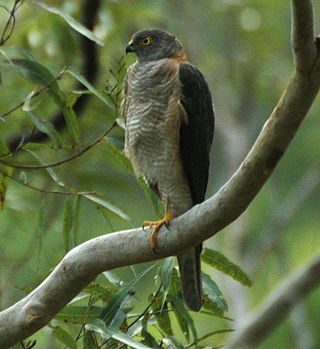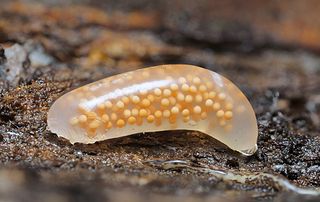
Herring are forage fish, mostly belonging to the family of Clupeidae.

The International Union for Conservation of Nature (IUCN) Red List of Threatened Species, also known as the IUCN Red List or Red Data Book, founded in 1964, is an inventory of the global conservation status and extinction risk of biological species. A series of Regional Red Lists, which assess the risk of extinction to species within a political management unit, are also produced by countries and organizations.

Accipiter is a genus of birds of prey in the family Accipitridae. With 49 recognized species it is the most diverse genus in its family. Most species are called goshawks or sparrowhawks, although with the exception of the American goshawk almost all New World species are simply known as "hawks". They can be anatomically distinguished from their relatives by the lack of a procoracoid foramen. Two small and aberrant species usually placed here do possess a large procoracoid foramen and are also distinct as regards DNA sequence. They may warrant separation in the old genus Hieraspiza.

Desmodus is a genus of bats which—along with the genera Diaemus and Diphylla—are allied as the subfamily Desmodontinae, the carnivorous, blood-consuming vampire bats of the New World leaf-nosed bat family Phyllostomidae.

The conservation status of a group of organisms indicates whether the group still exists and how likely the group is to become extinct in the near future. Many factors are taken into account when assessing conservation status: not simply the number of individuals remaining, but the overall increase or decrease in the population over time, breeding success rates, and known threats. Various systems of conservation status are in use at international, multi-country, national and local levels, as well as for consumer use such as sustainable seafood advisory lists and certification. The two international systems are by the International Union for Conservation of Nature (IUCN) and The Convention on International Trade in Endangered Species of Wild Fauna and Flora (CITES).

The Philippine tube-nosed fruit bat locally known in Tagalog as Bayakan is a species of bat in the family Pteropodidae. It is endemic to the Philippines and known from the islands of Cebu, Negros and Sibuyan. It occurs in and near primary and secondary subtropical or tropical dry forests. It is often found near water. The species is named for Dioscoro S. Rabor who, with several others, first collected the species.
Speleoperipatus is a monospecific genus of velvet worm in the Peripatidae family, containing the single species Speleoperipatus spelaeus. This species is a pale greenish yellow, almost white, with 22 or 23 pairs of legs and no eyes. Specimens range from 27 mm to 34 mm in length. The minimum number of leg pairs found in this species (22) is also the minimum number found in the neotropical Peripatidae. This velvet worm is viviparous, with mothers supplying nourishment to their embryos through a placenta.
Metacyclops is a genus of copepod crustaceans in the family Cyclopidae, containing 61 species, of which three are listed on the IUCN Red List – M. campestris from Brazil, M. gasparoi from Italy (vulnerable) and M. postojnae from Slovenia (vulnerable).
Paralithoxus stocki is a species of armored catfish endemic to French Guiana where it occurs in the Maroni and Mana River basins. This species grows to a length of 6.6 centimetres (2.6 in) SL.
On 29 January 2010, the IUCN Red List of Threatened Species identified three data deficient species in the Nemertina phylum.

The World's 25 Most Endangered Primates is a list of highly endangered primate species selected and published by the International Union for Conservation of Nature (IUCN) Species Survival Commission (SSC) Primate Specialist Group (PSG), the International Primatological Society (IPS), Global Wildlife Conservation (GWC), and Bristol Zoological Society (BZS). The IUCN/SSC PSG worked with Conservation International (CI) to start the list in 2000, but in 2002, during the 19th Congress of the International Primatological Society, primatologists reviewed and debated the list, resulting in the 2002–2004 revision and the endorsement of the IPS. The publication was a joint project between the three conservation organizations until the 2012–2014 list when BZS was added as a publisher. The 2018–2020 list was the first time Conservation International was not among the publishers, replaced instead by GWC. The list has been revised every two years following the biannual Congress of the IPS. Starting with the 2004–2006 report, the title changed to "Primates in Peril: The World's 25 Most Endangered Primates". That same year, the list began to provide information about each species, including their conservation status and the threats they face in the wild. The species text is written in collaboration with experts from the field, with 60 people contributing to the 2006–2008 report and 85 people contributing to the 2008–2010 report. The 2004–2006 and 2006–2008 reports were published in the IUCN/SSC PSG journal Primate Conservation,, since then they have been published as independent publications.

Argonemertes is a genus of nemertean worms belonging to the family Prosorhochmidae. It may be transferred to the family Plectonemertidae. It contains the following species:
Argonemertes hillii is a species of nemertean worms in the family Prosorhochmidae that is endemic to Australia, and is found east of the Great Dividing Range in northern New South Wales and southern Queensland. It inhabits in damp woodlands, dry sclerophyll forests and tropical and subtropical rainforests, and is usually found under logs.
Livingstone's yellow bat or Livingstone's house bat is a species of bat found in Africa.

Trujillo's yellow bat or Trujillo's house bat is a species of vesper bat endemic to Kenya.









